MERCEDES-BENZ E-CLASS WAGON 2018 Owner's Manual
Manufacturer: MERCEDES-BENZ, Model Year: 2018, Model line: E-CLASS WAGON, Model: MERCEDES-BENZ E-CLASS WAGON 2018Pages: 506, PDF Size: 6.73 MB
Page 371 of 506
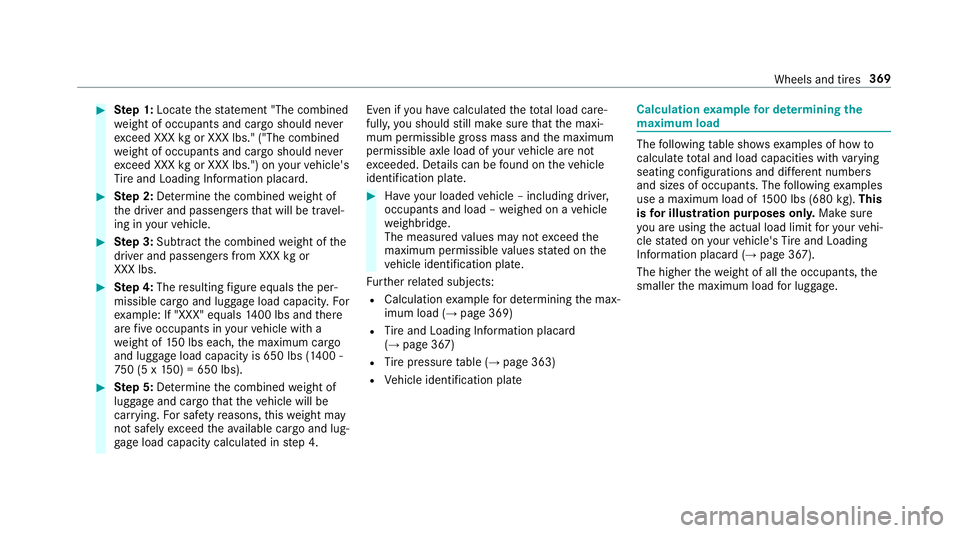
#Step 1: Locate thest atement "The combined
we ight of occupants and cargo should ne ver
exc eed XXX kgor XXX lbs." ("The combined
we ight of occupants and cargo should ne ver
exc eed XXX kgor XXX lbs.") on your vehicle's
Ti re and Loading Info rmation placard.
#Ste p 2: Determ ine the combined weight of
th e driver and passengers that will be tra vel‐
ing in your vehicle.
#Ste p 3: Subtract the combined weight of the
driver and passengers from XXX kgor
XXX lbs.
#Ste p 4: Theresulting figure equals the per‐
missible cargo and luggage load capacity. For
ex ample: If "XXX" equals 1400 lbs and there
are five occupants in your vehicle with a
we ight of 150 lbs each, the maximum cargo
and luggage load capacity is 650 lbs (1400 -
75 0 (5 x 150) = 650 lbs).
#Ste p 5: Determ ine the combined weight of
luggage and cargo that theve hicle will be
car rying. For saf etyre asons, this we ight may
not safely exceed theav ailable cargo and lug‐
ga ge load capacity calculated in step 4. Even if
you ha vecalculated thetot al load care‐
full y,yo u should still make sure that the maxi‐
mum permissible gross mass and the maximum
permissible axle load of your vehicle are not
exc eeded. De tails can be found on theve hicle
identification plate.
#Ha ve your loaded vehicle – including driver,
occupants and load – weighed on a vehicle
we ighbridge.
The measured values may not exceed the
maximum permissible values stated on the
ve hicle identification plate.
Fu rther related subjects:
RCalculation example for de term ining the max‐
imum load (→page 369)
RTi re and Loading Info rmation placard
(→page 367)
RTi re pressure table (→page 363)
RVe hicle identification plate
Calculation example for de term ining the
ma ximum load
The following table sho wsexamples of how to
calculate tota l and load capacities with varying
seating con figurations and dif fere nt numbe rs
and sizes of occupants. The following examples
use a maximum load of 1500 lbs (680 kg).This
is for illustration purposes on ly.Make sure
yo u are using the actual load limit foryo ur vehi‐
cle stated on your vehicle's Tire and Loading
Info rmation placard (
→page 367).
The higher thewe ight of all the occupants, the
smaller the maximum load for lug gage .
Wheels and tires 369
Page 372 of 506
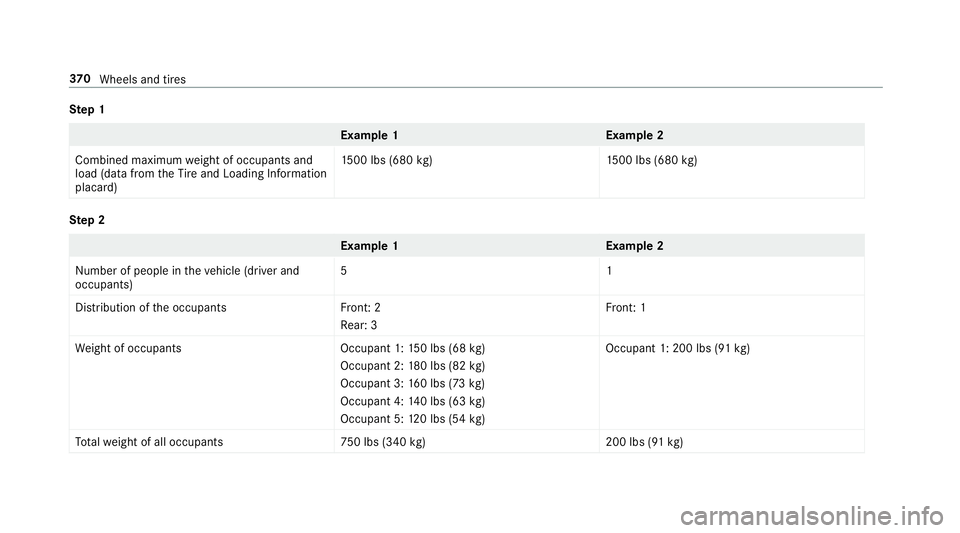
Step 1
Example 1E xamp le 2
Combined maximum weight of occupants and
load (data from theTire and Loading Info rmation
placard) 15
00 lbs (680 kg)1 500 lbs (680kg)
Ste p 2
Example 1E xamp le 2
Numb er of people in theve hicle (driver and
occupants) 51
Distribution of the occupant sF ront: 2
Re ar: 3 Fr
ont: 1
We ight of occupant sO ccupant 1:150 lbs (68 kg)
Occupant 2: 180 lbs (82 kg)
Occupant 3: 160 lbs (73 kg)
Occupant 4: 140 lbs (63 kg)
Occupant 5: 120 lbs (54 kg) Occupant 1: 200 lbs (91
kg)
To talwe ight of all occupant s7 50 lbs (340kg)2 00 lbs (91kg)
37 0
Wheels and tires
Page 373 of 506
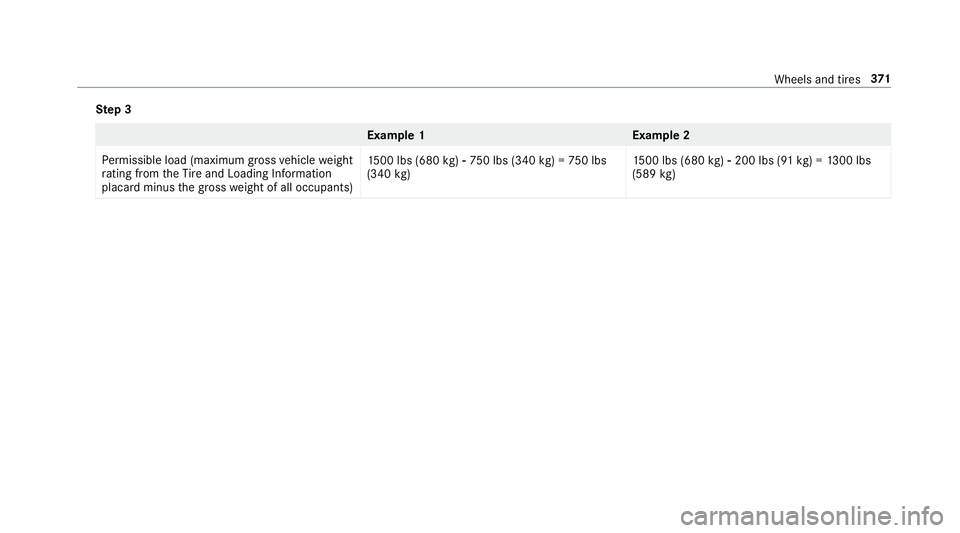
Step 3
Example 1E xamp le 2
Pe rm issible load (maximum grossve hicle weight
ra ting from theTire and Loading Info rmation
placard minus the gross weight of all occupants) 15
00 lbs (680 kg)Ò 75 0 lbs (340 kg) = 750 lbs
(340 kg) 15
00 lbs (680 kg)Ò 200 lbs (91 kg) = 1300 lbs
(589 kg)
Wheels and tires 37
1
Page 374 of 506
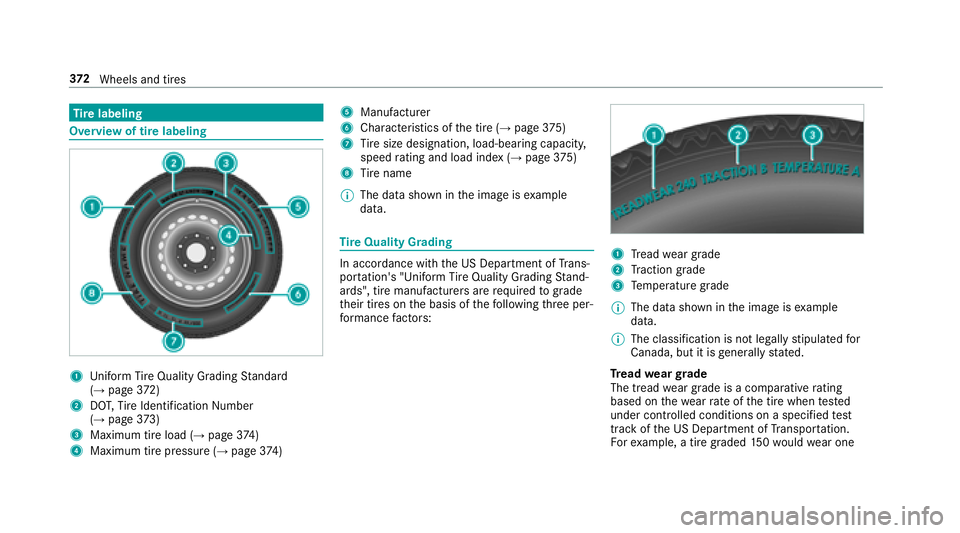
Tire labeling
Overview of tire labeling
1Uni form Ti reQuality Grading Standard
(→page 372)
2DO T,Tire Identification Number
(→page 373)
3Ma ximum tire load (→page 374)
4Maximum tire pressure (→page374)
5Ma nufactu rer
6Characteristics of the tire (→page 375)
7Tire size designation, load-beari ng capacity,
speed rating and load ind ex(→page 375)
8Tire name
% The da tashown in the image is example
data.
Ti re Quality Grading
In accordance with the US Department of Trans‐
por tation's "Unifo rm TireQuality Grading Stand‐
ards", tire manufacturers are requ ired tograde
th eir tires on the basis of thefo llowing thre e per‐
fo rm ance factors:1Tread weargrade
2Traction grade
3Te mp erature grade
% The data shown in the image is example
data.
% The classification is not legally stipulated for
Canada, but it is general lystated.
Tr ead weargrade
The tread wear grade is a comparative rating
based on thewe arrate ofthe tire when tested
under controlled conditions on a specified test
track of the US Department of Transpor tation.
Fo rex ample, a tire graded 150wo uld wear one
372
Wheels and tires
Page 375 of 506
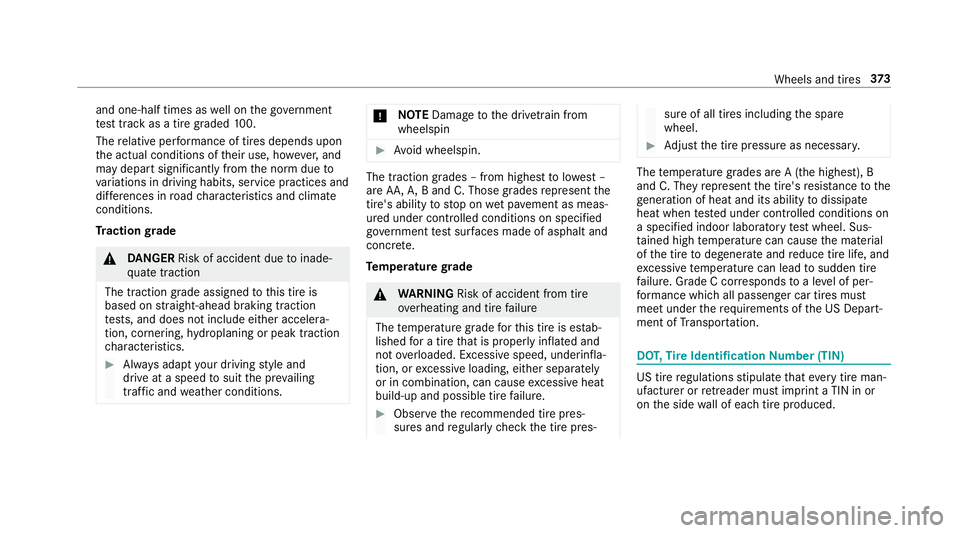
and one-half times aswell on the go vernment
te st track as a tire graded 100.
The relative per form ance of tires depends upon
th e actual conditions of their use, ho wever,and
may depart significantly from the norm due to
va riations in driving habits, service practices and
dif fere nces in road characteristics and climate
conditions.
Tr action grade
&
DANG ER Risk of accident due toinade‐
qu ate traction
The traction grade assigned tothis tire is
based on stra ight-ahead braking traction
te sts, and does not include either accelera‐
tion, cornering, hydroplaning or peak traction
ch aracteristics.
#Alw ays adapt your drivin gst yle and
drive at a speed tosuit the pr evailing
traf fic and weather conditions.
* NO
TEDama getothe driv etra in from
wheelspin
#Av oid wheelspin.
The traction grades – from highest tolowest –
are AA, A,B and C. Those grades represent the
tire's ability tostop on wet pa vement as meas‐
ured under controlled conditions on specified
go vernment test sur faces made of asphalt and
concr ete.
Te mp erature grade
&
WARNING Risk of accident from tire
ove rheating and tire failure
The temp erature grade forth is tire is es tab‐
lished for a tire that is proper ly inflated and
not overloaded. Excessive speed, underinfla‐
tion, or excessive loading, either separately
or in combination, can cause excessive heat
build-up and possible tire failure.
#Obser vethere commended tire pres‐
sure s and regularly check the tire pres‐
sure of all tires including the spare
wheel.
#Ad just the tire pressure as necessar y.
Thetemp erature grades are A (the highest), B
and C. They represent the tire's resis tance tothe
ge neration of heat and its ability todissipate
heat when tested under controlled conditions on
a specified indoor laboratory test wheel. Sus‐
ta ined high temp erature can cause the material
of the tire todegenerate and reduce tire life, and
exc essive temp erature can lead tosudden tire
fa ilure. Grade C cor responds toa le vel of per‐
fo rm ance which all passenger car tires must
meet under therequ irements of the US Depart‐
ment of Transpor tation.
DO T,Tire Identification Number (TIN)
US tire regulations stipulate that eve rytire man‐
ufactu rer or retreader must imprint a TIN in or
on the side wall of each tire produced.
Wheels and tires 37
3
Page 376 of 506
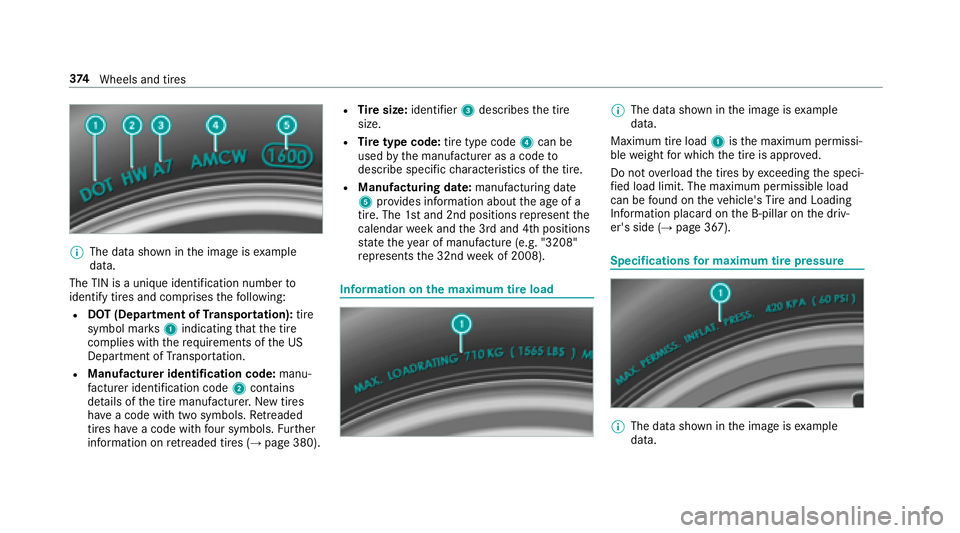
%The data shown in the image is example
data.
The TIN is a unique identification number to
identify tires and comprises thefo llowing:
RDOT (Department of Transport ation):tire
symbol mar ks1 indicating that the tire
complies with therequ irements of the US
Department of Transpor tation.
RManufacturer identi fication code: manu‐
fa cturer identification code 2contains
de tails of the tire manufacturer. New tires
ha ve a code with two symbols. Retreaded
tires ha vea code with four symbols. Further
information on retreaded tires (
→pa ge 380).
RTire size: identifier 3describes the tire
size.
RTi re type code: tire type code 4can be
used bythe manufacturer as a code to
describe specific characteristics of the tire.
RManufacturing date: manufacturing date
5 prov ides information about the age of a
tire. The 1st and 2nd positions represent the
calendar week and the 3rd and 4th positions
st ate theye ar of manufacture (e.g. "3208"
re presents the 32nd week of 2008).
Information on the maximum tire load
%
The data shown in the image is example
data.
Maximum tire load 1isthe maximum permissi‐
ble weight for which the tire is appr oved.
Do not overload the tires by exceeding the speci‐
fi ed load limit. The maximum permissible load
can be found on theve hicle's Tire and Loading
Info rmation placard on the B-pillar on the driv‐
er's side (
→page 367).
Specifications for maximum tire pressure
%
The da tashown in the image is example
data.
37 4
Wheels and tires
Page 377 of 506
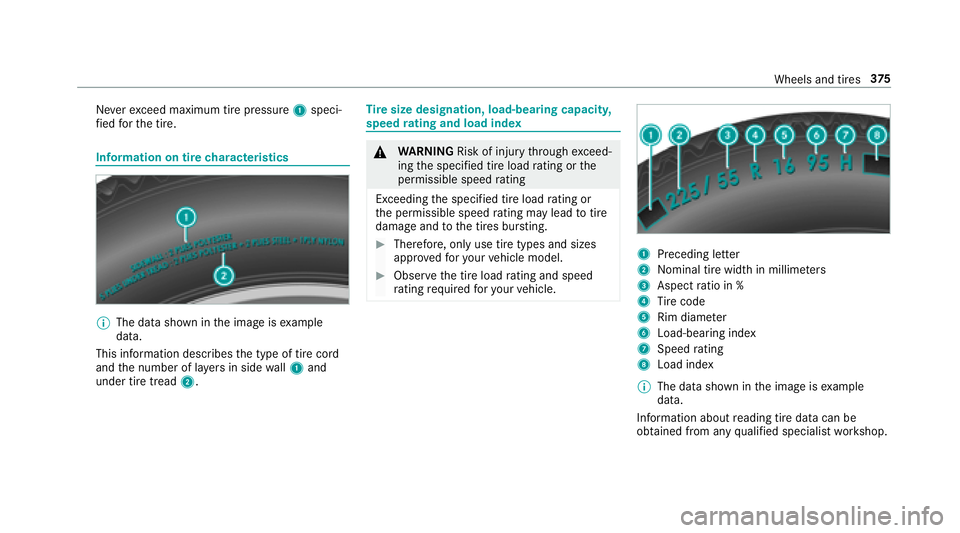
Neverexc eed maximum tire pressure 1speci‐
fi ed forth e tire.
Information on tire characteristics
%
The data shown in the image is example
data.
This information descri besthe type of tire cord
and the number of la yers in side wall1 and
under tire tread 2.
Tire size designation, load-bearing capacity,
speed rating and load index
&
WARNING Risk of injury thro ugh exceed‐
ing the specified tire load rating or the
permissible speed rating
Exceeding the specified tire load rating or
th e permissible speed rating may lead totire
damage andtothe tires bur sting.
#Therefore, only use tire types and sizes
appr ovedfo ryo ur vehicle model.
#Obser vethe tire load rating and speed
ra ting requ ired foryo ur vehicle.
1Preceding letter
2Nominal tire width in millime ters
3Aspect ratio in %
4Tire code
5Rim diame ter
6Load-bearing index
7Speed rating
8Load ind ex
% The data shown in the image is example
data.
Info rmation about reading tire data can be
obtained from any qualified specialist workshop.
Wheels and tires 37
5
Page 378 of 506
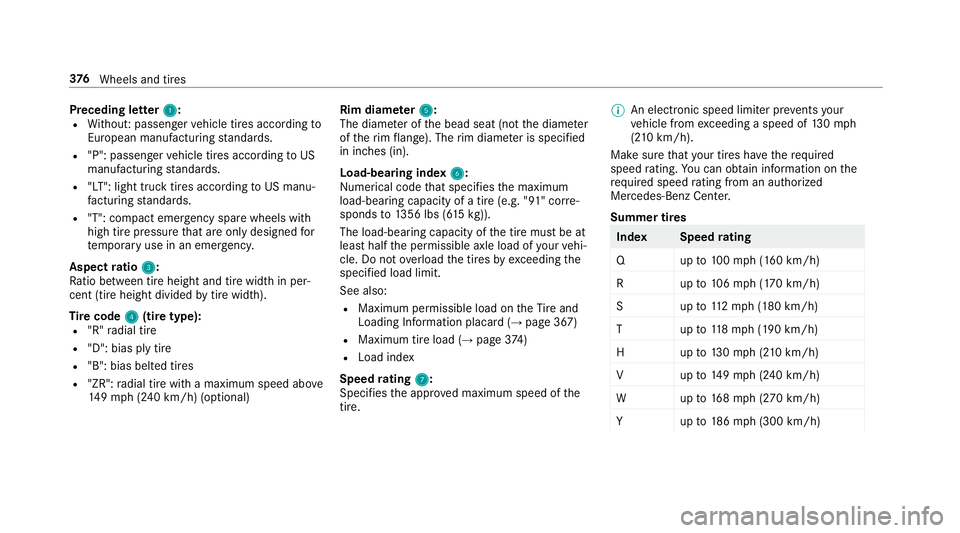
Preceding letter1:RWithout: passenger vehicle tires according to
European manufactu ring standards.
R"P": passenger vehicle tires according toUS
manufacturing standards.
R"LT": light truck tires according toUS manu‐
fa cturing standards.
R"T": compact emer gency spa rewheels with
high tire pressure that are only designe dfo r
te mp orary use in an emer gency.
Aspect ratio 3
:
Ra tio between tire height and tire width in per‐
cent (ti reheight divided bytire width).
Tire code 4
(tire type):R"R" radial tire
R"D": bias ply tire
R"B": bias belted tires
R"ZR": radial tire with a maximum speed abo ve
14 9mp h (240 km/h) (optional) Rim diame
ter5
:
The diam eter of the bead seat (not the diame ter
of therim flange). The rim diame ter is specified
in inches (in).
Load-bearing index 6
:
Numerical code that specifies the maximum
load-bearing capacity of a tire (e.g. "91" cor re‐
sponds to1356 lbs (6 15kg)).
The load-bearing capacity of the tire must be at
least half the permissible axle load of your vehi‐
cle. Do not overload the tires byexc eeding the
specified load limit.
See also:
RMaximum permissible load on theTire and
Loading Info rmation placard (→page 367)
RMaximum tire load (→page 374)
RLoad inde x
Speed rating 7
:
Specifies the appr oved maximum speed of the
tire. %
An electronic speed limite r prevents your
ve hicle from exceeding a speed of 130mp h
(2 10 km/h).
Make surethat your tires ha vetherequ ired
speed rating. You can obtain information on the
re qu ired speed rating from an au thorized
Mercedes-Benz Center.
Summer tires
Inde xS peedrating
Qu pto 100mp h (160 km/h)
Ru pto 106mp h (170 km/h)
Su pto 112mp h(1 80 km/h)
Tu pto 118mp h (190 km/h)
Hu pto 130mp h(210 km/h)
Vu pto 149mp h(2 40 km/h)
Wu pto 168mp h (270 km/h)
Yu pto 186mp h(3 00 km/h)
37 6
Wheels and tires
Page 379 of 506
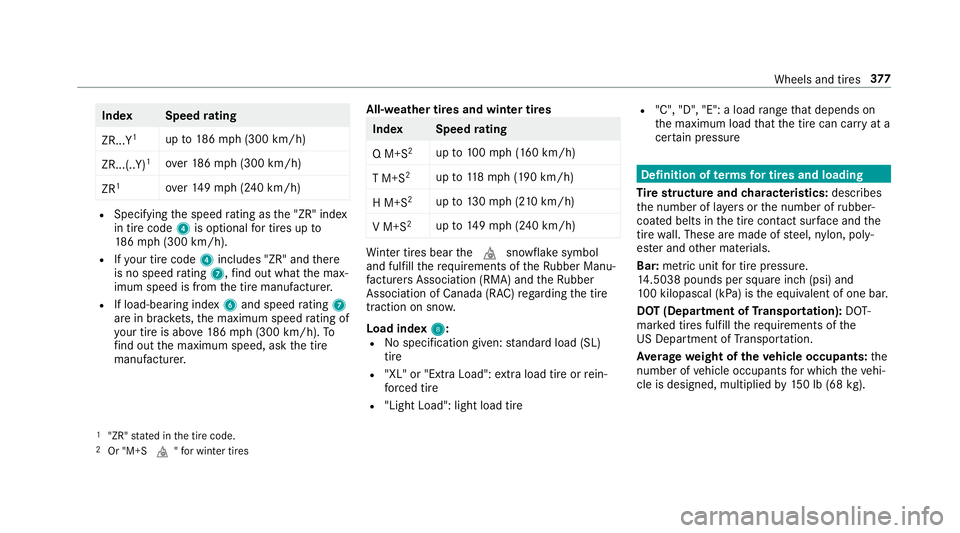
IndexS peedrating
ZR...Y
1up to186mp h(3 00 km/h)
ZR...(..Y)
1ove r18 6mp h(3 00 km/h)
ZR
1ove r14 9mp h (240 km/h)
RSpecifying the speed rating as the "ZR" index
in tire code 4is optional for tires up to
18 6mp h(3 00 km/h).
RIfyo ur tire co de4 includes "ZR"andthere
is no speed rating 7,find out what the max‐
imum speed is from the tire manufacturer.
RIf load-bearing index 6and speed rating 7
are in brac kets, the maximum speed rating of
yo ur tire isabo ve186mp h (300 km/h). To
fi nd out the maximum speed, ask the tire
manufacturer. All-weather tires and winter tires
Inde
xS peedrating
Q M+S
2up to100mp h (160 km/h)
T M+S
2up to118mp h(190 km/h)
H M+S
2up to130mp h (2 10km/h)
V M+S
2up to149mp h (240 km/h)
Winter tires bear thei snowflake symbol
and fulfill therequ irements of theRu bber Manu‐
fa cturers Association (RMA) and theRu bber
Association of Canada (RAC) rega rding the tire
traction on sno w.
Load index 8
:RNo specification given: standard load (SL)
tire
R"XL" or "Extra Load": extra load tire or rein‐
fo rc ed tire
R"Light Load": light load tire
R"C", "D", "E": a load range that depends on
th e maximum load that the tire can car ryat a
cer tain pressure
Definition of termsfo r tires and loading
Ti re stru ctureand characteristics: describes
th e number of la yers or the number of rubber-
coated belts in the tire conta ct surface and the
tire wall. These are made of steel, nylon, poly‐
es ter and other materials.
Bar: metric unit for tire pressure .
14 .5038 pounds per square inch (psi) and
10 0 kilopascal (kPa) is the equivalent of one bar.
DOT (Department of Transport ation):DOT-
mar ked tires fulfill therequ irements of the
US Department of Transpor tatio n.
Av erage weight of theve hicle occupants: the
number of vehicle occupants for which th eve hi‐
cle is designed, multiplied by150 lb (68 kg).
1"ZR" stated in the tire code.2Or "M+S i"for winter tires
Wheels and tires 37
7
Page 380 of 506
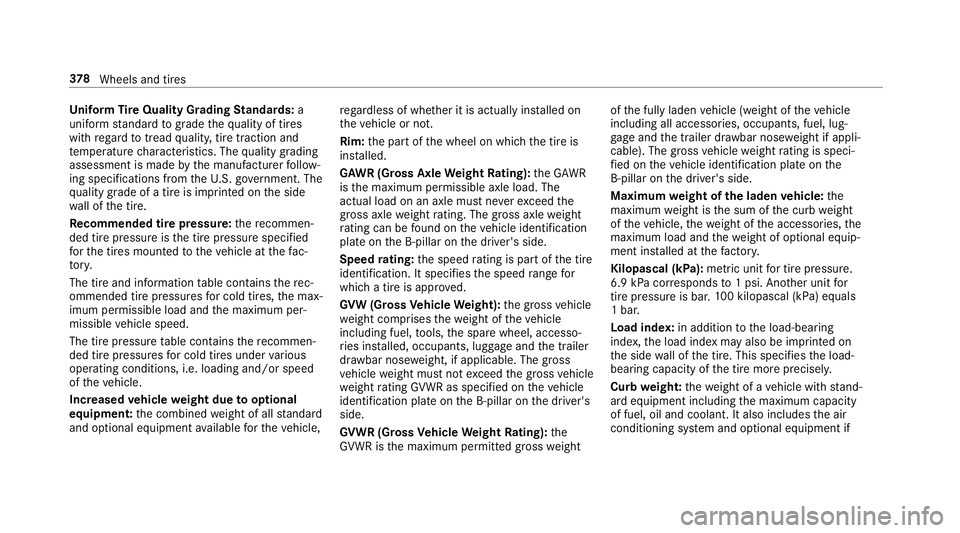
Uniform Tire Quality Grading Standards: a
uniform standard tograde thequ ality of tires
with rega rd totread quality, tire traction and
te mp erature characteristics. The quality grading
assessment is made bythe manufacturer follow‐
ing specifications from theU. S. go vernment. The
qu ality grade of a tire is imprinted on the side
wa ll of the tire.
Re commended tire pressure :th ere commen‐
ded tire pressure is the tire pressure specified
fo rth e tires mounted totheve hicle at thefa c‐
to ry.
The tire and information table conta insthere c‐
ommended tire pressures for cold tires, the max‐
imum permissible load and the maximum per‐
missible vehicle speed.
The tire pressure table conta insthere commen‐
ded tire pressures for cold tires under various
operating conditions, i.e. loading and/or speed
of theve hicle.
Increased vehicle weight due tooptional
equipment: the combined weight of all standard
and optional equipment available forth eve hicle, re
ga rdless of whe ther it is actually ins talled on
th eve hicle or not.
Rim: the part of the wheel on which the tire is
ins talled.
GA WR (Gross Axle Weight Rating): the GAWR
is the maximum permissible axle load. The
actual load on an axle must ne verexc eed the
gros s axle weight rating. The gross axle
weight
ra ti
ng can be found on theve hicle identification
plate on the B‑pillar on the driver's side.
Speed rating: the speed rating is pa rtof the tire
identification. It specifies the speed range for
which a tire is appr oved.
GV W (Gross Vehicle Weight): the gross vehicle
we ight comprises thewe ight of theve hicle
including fuel, tools, the spare wheel, accesso‐
ri es ins talled, occupants, luggage and the trailer
dr aw bar nose weight, if applicable. The gross
ve hicle weight must not exceed the gross vehicle
we ight rating GVWR as specified on theve hicle
identification plate on the B‑pillar on the driver's
side.
GV WR (Gross Vehicle Weight Rating): the
GV WR is the maximum permitted gross weight of
the fully laden vehicle (weight of theve hicle
including all accessories, occupants, fuel, lug‐
ga ge and the trailer dr awbar nose weight if appli‐
cable). The grossve hicle weight rating is speci‐
fi ed on theve hicle identification plate on the
B‑pillar on the driver's side.
Maximum weight of the laden vehicle: the
maximum weight is the sum of the curb weight
of theve hicle, thewe ight of the accessories, the
maximum load and thewe ight of optional equip‐
ment ins talled at thefa ctor y.
Kilopascal (kPa): metricunit for tire pressure .
6.9 kPa cor responds to1 psi. Ano ther unit for
tire pressure is bar.10
0 ki
lopascal (kPa) equals
1 bar.
Load index: in additiontothe load-bearing
index, the load index may also be imprinted on
th e side wall of the tire. This specifies the load-
bearing capacity of the tire more precisel y.
Curb weight: thewe ight of a vehicle with stand‐
ard equipment including the maximum capacity
of fuel, oil and coolant. It also includes the air
conditioning sy stem and optional equipment if
37 8
Wheels and tires